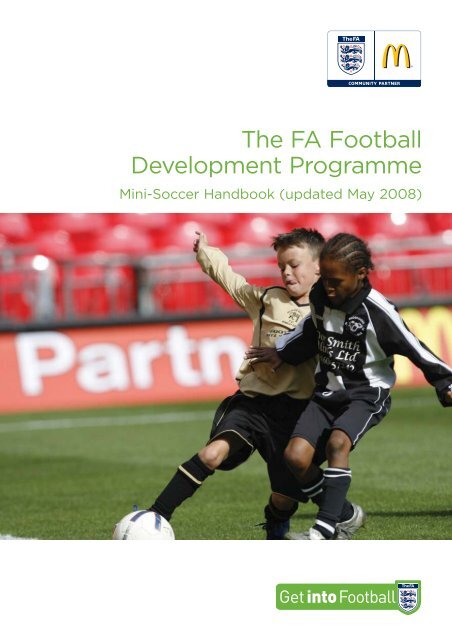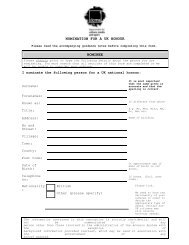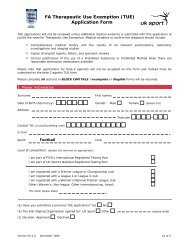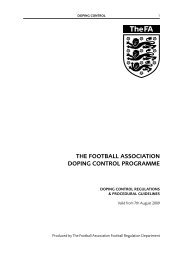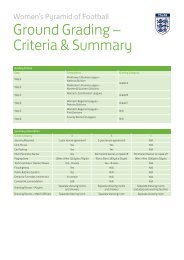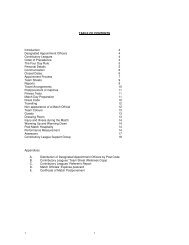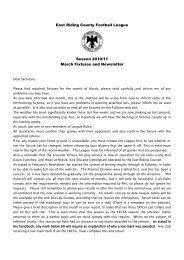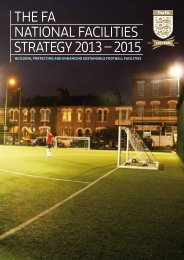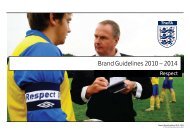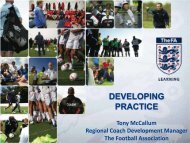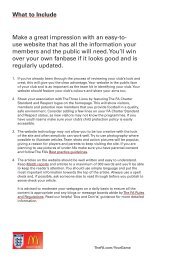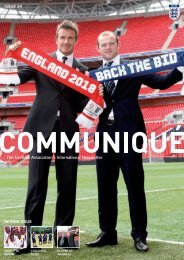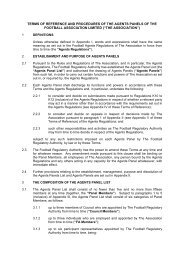Mini-Soccer Handbook - The Football Association
Mini-Soccer Handbook - The Football Association
Mini-Soccer Handbook - The Football Association
You also want an ePaper? Increase the reach of your titles
YUMPU automatically turns print PDFs into web optimized ePapers that Google loves.
<strong>The</strong> FA <strong>Football</strong>Development Programme<strong>Mini</strong>-<strong>Soccer</strong> <strong>Handbook</strong> (updated May 2008)
<strong>The</strong> Best Introduction tothe World’s Greatest GameSeptember 1999 saw theimplementation of <strong>Mini</strong>-<strong>Soccer</strong>for all children under 10 yearsof age.After nearly three years ofconsultation and co-operationbetween all bodies involvedwith children’s football, boysand girls are now introduced tothe game on smaller pitcheswith scaled down goal postsand fewer players.<strong>The</strong> <strong>Football</strong> <strong>Association</strong> deems<strong>Mini</strong>-<strong>Soccer</strong> the most appropriateand fun introduction to footballby providing quality experiencesfor all young players.It allows greater involvement inthe game, with more touches,dribbles and passes.In attempting to provide qualityexperiences for young players atall levels, <strong>The</strong> <strong>Football</strong> <strong>Association</strong>deems <strong>Mini</strong>-<strong>Soccer</strong> the mostappropriate and fun introductionto football.1
<strong>Mini</strong>-<strong>Soccer</strong>: Meeting theNeeds of Children“<strong>The</strong> children are more importantthan the activities in which theyare engaged. <strong>The</strong> game is notthe thing, the child is.” PhysicalEducation for ages 5-16(Department of Educationand Science, August 1991).”<strong>The</strong> main theme throughout<strong>Mini</strong>-<strong>Soccer</strong> is to meet theneeds of children. Eleven-a-side<strong>Association</strong> <strong>Football</strong> does notmeet those needs. Childrenneed a modified game that fitstheir needs; too often childrenare modified to meet therequirements of a game.<strong>Mini</strong>-<strong>Soccer</strong> modifiesassociation football withoutlosing the essence of thegame. <strong>Mini</strong>-<strong>Soccer</strong> modifies<strong>Association</strong> <strong>Football</strong> withoutlosing the essence of the game.<strong>Mini</strong>-<strong>Soccer</strong> is the appropriateintroduction to football. Allavailable research andobservation shows that childrenwill have more fun and learnmore playing a game with smallerteams and modified rules.<strong>Mini</strong>-<strong>Soccer</strong> is, therefore, agame children can actuallyplay rather than struggling tounderstand a game createdfor adults.If children are to enjoy and takepart in soccer they need to:• Feel success• Take an active part inthe game• Learn to play as a team• Understand the Laws• Develop soccer skills• Be able to take part whatevertheir ability• Develop fitness<strong>Mini</strong>-<strong>Soccer</strong> sets out to meetthose needs. <strong>Mini</strong>-<strong>Soccer</strong> setsout to meet those needs. Itallows children to succeedand take part in somethingthat is still recognisably football.It allows children to succeedand take part in something thatis still recognisably football.2
<strong>Mini</strong>-<strong>Soccer</strong> recognises the factthat younger children performbetter in smaller teams withsimple Laws.<strong>Mini</strong>-<strong>Soccer</strong>, however, ismore than another version of5-or 6-a-side football for thefollowing reasons:1. It recognises that children donot perform as adults andtherefore its Laws, researchedand piloted by <strong>The</strong> <strong>Football</strong><strong>Association</strong>, meet the needsof children.2. It has all the features of ‘real’football to children.3. It doesn’t set unrealisticexpectations. Many adults donot know what can be expectedof children and so emphasisethe result at the expense ofperformance. <strong>Mini</strong>-<strong>Soccer</strong>helps by defining the targetsfor children at different ages.4. It sets a standard and aframework for behaviour onand off the pitch.5. <strong>Mini</strong>-<strong>Soccer</strong> is for allyoungsters regardless of theirability. It is intended for girlsand boys, and youngfootballers with disabilitiesand learning difficulties.In an age when so much ofchildren’s leisure time is asorganised as their study, <strong>Mini</strong>-<strong>Soccer</strong> offers something special:a game that children canorganise themselves! Withrelatively little instructionchildren can play and enjoy agame which is suitable for awide ability range and giveseveryone a chance to take part.If you find this hard to believe,just set up a game with somechildren and WATCH!3
Guidance for the Lawsof <strong>Mini</strong>-<strong>Soccer</strong><strong>The</strong> Laws have been piloted andaim to be simple and as near to‘real’ football as possible. <strong>The</strong>games require only a ‘gameleader’who is urged to be asflexible as possible with theyoungest children.<strong>The</strong> children will need theLaws explained to them as thegame proceeds (e.g. handball,in/out of play).It will also be necessaryto demonstrate in certaininstances how to re-start thegame (e.g. throw-ins).4
What can ChildrenExpect from Adults?Remember that children areoften easily led, anxious toplease and prone to overenthusiasm,and so plenty ofpraise and positivereinforcement is needed –especially with beginners.Children find it hard tounderstand negative instructionsand easier to understandpositive reinforcement; thiscan frequently mean playingdown the result and playing upthe performance.This reduces the child’s anxietyand decreases their worry aboutfailing. Remember that childrendo not mean to make mistakes;we should accept mistakes as anecessary part of learning.Make sure the players play bythe Laws. <strong>The</strong> majority of childrenat these ages will not knowinglyinfringe the Laws of the Game.Finally, work with other adults,not against them, and by sodoing reinforce positive attitudesamong the children.5
Interference from theTouch LineWhilst the fun and friendlyatmosphere created by <strong>Mini</strong>-<strong>Soccer</strong> should keep suchinstances to a minimum, theremay be situations which arisewhere comments and abusefrom adults, parents andManagers is made from thetouch line.This could be directed at theReferee, but also at the players.What can be done? Stay calm;do not get into disagreement;report the matter to relevantclub or league officials; set apositive responsible example.Remember <strong>The</strong> FA’sRESPECT campaign.6
Referees – <strong>Mini</strong>-<strong>Soccer</strong>Game Leaders<strong>The</strong> Referee will have animportant role to play in <strong>Mini</strong>-<strong>Soccer</strong>. Carrying out their dutieswithout favour they should lookto create a playing environmentwhich is fun for all taking part.<strong>The</strong> Referee should encouragefair play, fun, respect for others,development of skills and teamwork, understanding of theLaws of the Game.<strong>The</strong> Laws of the Game shouldbe a guide for the Referee in<strong>Mini</strong>-<strong>Soccer</strong> with the spirit ofthe laws being more importantthan the letters of the law.Appreciation of the needs ofthe child are essential.7
9v9During the 2002-03 season anumber of leagues approached<strong>The</strong> FA regarding the possibilityof moving to 9v9 at under 11.<strong>The</strong> FA organised a numberof Regional <strong>Mini</strong>-<strong>Soccer</strong>Consultation Meetings to review<strong>Mini</strong>-<strong>Soccer</strong> and to discuss ideasfor the future development ofthe game.<strong>The</strong> consultation also lead to theintroduction, within FA rules, forthe 9v9 game for children whohave reached the age of 10 on31st August.<strong>The</strong> 9v9 option is available fromU11-U14.When 9v9 is played <strong>The</strong> FArecommends the following:Follow 11v11 laws of the game,except:• Size of pitch: use juniorsize pitch 80 x 50 yards andjunior goals 16’ x 7’. It hasbeen agreed by <strong>The</strong> FAthat for season 2008/09,the use of any sized goalswill be permissible forthe 9v9 game, whilst atransitional periodcontinues to exist in thisformat of the game.However, there isrecognition that the 16’ x 7’goals are most suitableduring matches and as suchclubs should be encouragedto make the most of the<strong>Football</strong> Foundation’sfunding to gain this sizeof goal. From season2009/10, only goals sized16’ x 7’ will be permissible.• Substitutes: Maximumsquad of 18 with repeatsubstitutions allowed• Playing Time: Maximum35mins each way• Anything not coveredabove, FA standard codeof rules for youth leaguesapply.<strong>The</strong> FA hopes that, wherefacilities allow leagues will makeuse of the 9v9 option to assistthe players’ development.8
<strong>The</strong> <strong>Football</strong> <strong>Association</strong> Lawsfor <strong>Mini</strong>-<strong>Soccer</strong>For Players (both boys and girlsover the Age of 6 and under 10)(Updated by <strong>The</strong> FA Council on 15th May 2008)Please note: Where Leagues operate Under 11 <strong>Mini</strong>-<strong>Soccer</strong> events, they mustfollow these Laws.Please remember:Under 7’s or Under 8’s are not permitted to play in leagues where results arecollected or published or winner trophies are presented, this is deemed to bedetrimental to the development of the player and the game and will not besanctioned. To play in a KO Cup game or a game where points are awarded,or results collected, a player must have achieved the age of 8 on or before31st August.Except where other provision, in these Laws are made, the Laws of <strong>Association</strong> <strong>Football</strong> apply. Each Law isnumbered to correspond with the appropriate Law of the Game. <strong>The</strong>se Laws are mandatory unless specialpermission is granted by <strong>The</strong> <strong>Football</strong> <strong>Association</strong>.10
Law 1Playing Area8 yds7.32 m 18 yds16.47 m10 yds9.15 m11
<strong>The</strong> <strong>Football</strong> <strong>Association</strong> Laws for<strong>Mini</strong>-<strong>Soccer</strong>WARNINGPlease ensure that <strong>The</strong> FA Goalpost safetyguidelines are observed.Under 10s/9sUnder 8s/7sMetres Yards Metres YardsWidthMin. 27.45Max. 36.60Min. 30Max. 40Min. 18.30Max. 27.45Min. 20Max. 30LengthMin. 45.75Max. 54.90Min. 50Max. 60Min. 27.45Max. 45.75Min. 30Max. 50Penalty AreaLength 9.15m – 10 yards; Width 16.47m – 18 yards.Penalty Mark<strong>The</strong> penalty mark is 7.32m (8 yards) from the Goal Line opposite the Centre of the Goal.Halfway Line<strong>The</strong> field of play is divided into two halves by a halfway line. <strong>The</strong> centre mark is indicated at the mid-pointof the halfway line.Goal Size<strong>The</strong> distance between the posts is 3.6m (12ft) and the distance between the lower edge of the cross barand the ground is 1.88m (6ft).12
Law 2<strong>The</strong> Ball• <strong>The</strong> ball should be size 4 for U9/U10.• Size 3 for Under 8s.Law 3Number of Players• It should be safe and made of leather or another suitable materialNumber per Team, including GoalkeeperUnder 10s/9s6 v 6 or 7 v 7Under 8/74 v 4, 5 v 5, 6 v 6 or 7 v 7Where the appropriate facilities are available, the FA would encourage leagues and competitions to use thesmaller number of players at the youngest age group.Players must play with and against players only from their own age range, as per <strong>Football</strong> <strong>Association</strong>and Competition rules.Each team must not have a squad greater than double the size of the team per age.Any number of substitutes, without being named, may be used at any time with the permission of thereferee or game leader. Entry into the field of play will only be allowed during a stoppage in play. A playerwho has been replaced may return to the playing area as a substitute for another player.13
<strong>The</strong> <strong>Football</strong> <strong>Association</strong> Laws for<strong>Mini</strong>-<strong>Soccer</strong>Law 4Playing EquipmentPlayers must wear shin guards and goalkeepers must wear a distinguishing playing strip.Shin guards must be covered entirely by the stockings.Law 5Referees<strong>The</strong> Authority of the RefereeEach match is controlled by a referee who has full authority to enforce the Laws of the Game in connectionwith the match to which they have been appointed.Powers and Duties<strong>The</strong> Referee:• Enforces the Laws of the Game• Controls the match in co-operation with the assistant referees/time keeper• Ensures that the ball meets the requirements of Law 2• Ensures that the players’ equipment meets the requirements of Law 4• Stops, suspends or terminates the match, at their discretion, for any infringements of the Laws• Stops, suspends or terminates the match because of outside interference of any kind• Stops the match if, in their opinion, a player is seriously injured and ensures that they are removedfrom the field of play• Ensures that any player bleeding from a wound leaves the field of play• Allows play to continue when the team against which an offence has been committed will benefitfrom such an advantage and penalises the original offence if the anticipated advantage does notensue at that time14
Law 5 (continued)Referees• Takes disciplinary action against players guilty of cautionable and/or sending-off offences• Takes action against team officials who fail to conduct themselves in a responsible manner and may,at their discretion, expel them from the field of play and its immediate surrounds• Ensures that no unauthorised persons enter the field of play• Restarts the match after it has been stoppedDecisions of the Referee<strong>The</strong> decisions of the referee regarding facts connected with play are final.<strong>The</strong> referee may only change a decision on realising that it is incorrect or, at his/her discretion provided thatplay has not restarted.Law 6Timekeeper/Scorer/Assistant RefereeDutiesA person may be nominated to assist the referee to:a) Record goals scoredb) Act as timekeeper and signify to the referee by an agreed signal when the time of each half hasexpiredc) Suspend time on an instruction from the referee for all stoppages and add that time to the end ofeach halfd) Supervise the use of rolling substitutese) Carry out any other duties as prescribed by the refereeIf an independent timekeeper/scorer is not nominated, these duties are the responsibility of the referee.15
<strong>The</strong> <strong>Football</strong> <strong>Association</strong> Laws for<strong>Mini</strong>-<strong>Soccer</strong>Law 7Duration of the GameIn any one day, no player shall play more than the stipulated period outlined below.• Under 7 & Under 8s: 40 minutes• Under 9 & Under 10s: 60 minutesEach league/competition will determine its own playing time within the maximum time permitted.<strong>The</strong> half time interval must not exceed 5 minutes.Please refer to the Standard Code of rules for Youth Leagues.Law 8Start and Restart of PlayProcedureA kick-off is taken at the centre of the playing area to start the game and after a goal has been scored.Opponents must be 4.5m (5 yards) away from the ball, and in their own half of the field. <strong>The</strong> ball mustbe played forward. In <strong>Mini</strong> <strong>Soccer</strong> a goal cannot be scored directly from a start or restart of play.Special CircumstancesA dropped ball to restart the match, after play has been temporarily stopped inside the penalty area, takesplace on the penalty area line parallel to the goal line at the point nearest to where the ball was locatedwhen the play stopped.16
Law 9Ball In and Out of PlayBall Out of Play<strong>The</strong> ball is out of play when:• It has wholly crossed the goal line or touch line whether on the ground or in the air• Play has been stopped by the refereeBall In Play<strong>The</strong> ball is in play at all other times, including when:• It rebounds from a goal or post, crossbar or corner flag post and remains in the field of play• It rebounds from either the referee or an assistant referee when they are on the field of play17
Law 12Fouls and MisconductIn <strong>Mini</strong>-<strong>Soccer</strong> all free kicks are direct.A free kick is awarded to the opposing team if a player commits any of the following offences in a mannerconsidered to be careless, reckless or using excessive force:• Kicks or attempts to kick an opponent• Trips or attempts to trip an opponent• Jumps at an opponent• Charges an opponent• Strikes or attempts to strike an opponent• Pushes an opponentA free kick is awarded to the opposing team if a player commits any of the following offences:• Tackles an opponent to gain possession of the ball, making contact with the opponent beforetouching the ball• Holds an opponent• Spits at an opponent• Handles the ball deliberately (except for the goalkeeper within his/her own penalty area)• Plays in a dangerous manner• Impedes the progress of an opponent• Prevents the goalkeeper from releasing the ball from his/her hands• Commits any other offence, not previously mentioned in Law 12, for which play is stopped to cautionor dismiss a player19
<strong>The</strong> <strong>Football</strong> <strong>Association</strong> Laws for<strong>Mini</strong>-<strong>Soccer</strong>Penalty KickA penalty kick is awarded if any of the above offences is committed by a player inside his/her own penaltyarea, irrespective of the position of the ball, provided it is in play.A free kick is awarded to the opposing team if the goalkeeper:• Takes more than 6 seconds to release the ball from his/her hands• Touches the ball again with his/her hands after it has been released from his/her possession and hasnot touched any other player• Touches the ball with his/her hands after it has been deliberately kicked to him/her by a team mate• Touches the ball with his/her hands after he/she has received it directly from a throw in taken by ateam mateFor all these offences, the free kick should be taken from the penalty area line, parallel with the goal line, atthe nearest point to the offence.Cautionable OffencesA player is cautioned and shown the yellow card if he/she commits any of the following seven offences:1. Is guilty of unsporting behaviour2. Shows dissent by word or action3. Persistently infringes the Laws of the Game4. Delays the restart of play5. Fails to respect the required distance when play is restarted with a corner kick or free kick6. Enters or re-enters the field of play without the referee’s permission7. Deliberately leaves the field of play without the referee’s permission20
Law 12 (continued)Fouls and MisconductSending Off OffencesA player is sent off and shown the red card if he/she commits any of the following seven offences:1. Is guilty of serious foul play2. Is guilty of violent conduct3. Spits at an opponent or any other person4. Denies the opposing team a goal or an obvious goal scoring opportunity, by deliberately handling theball (this does not apply to a goalkeeper within his/her own penalty area)5. Denies an obvious goal scoring opportunity to an opponent moving towards the player’s goal by anoffence punishable by a free kick or penalty kick6. Uses offensive or insulting or abusive language and/or gestures7. Receives a second caution in the same matchLaw 13Free KicksFor all free kicks opponents must be 4.5m (5 yards) from the ball.Law 14Penalty KicksA penalty kick is awarded for offences, as described in Law 12.(continued)21
<strong>The</strong> <strong>Football</strong> <strong>Association</strong> Laws for<strong>Mini</strong>-<strong>Soccer</strong>Law 14 (continued)Penalty KicksPosition of the Ball and the PlayersAll players except the defending goalkeeper and kicker must be outside the penalty area and at least 4.5m(5 yards) from the penalty mark.<strong>The</strong> ball must be kicked forward.Infringement/SanctionsIf a player or players commit an offence at the taking of a penalty kick his/her team shall not be allowed togain an advantage (i.e. the kick is retaken or the goal is disallowed depending on which team offended).If a player of both the defending and the attacking teams offend, the kick shall be retaken.Law 15Throw-inA goal cannot be scored directly from a throw-in.A throw-in is awarded:• When the whole of the ball passes over the touch line, either on the ground or in the air• From the point where it crossed the touch line• To the opponents of the player who last touched the ballProcedureAt the moment of delivering the ball, the thrower:22
• Faces the field of play• Has part of each foot either on the touch line or on the ground outside the touch line• Uses both hands• <strong>The</strong> throw-in is awarded to the opposing team, if any of these requirements are not carried out• Delivers the ball from behind and over their head<strong>The</strong> thrower may not touch the ball again until it has touched another player. If he/she does, a free kick willbe awarded against them. <strong>The</strong> ball is in play immediately when it enters the field of play.Law 16Goal KickProcedureA player of the defending team kicks the ball from any point within the penalty area.Opponents must remain outside the penalty area and at least 4.5m (5 yards) from where the kick is takenuntil the ball is in play.Law 17Corner Kicks<strong>The</strong> opposing players must remain at least 4.5m (5yards) from the ball until it is in play.<strong>The</strong> kicker may not touch the ball again until it has touched another player. If he/she does, a free kick isawarded against them.<strong>The</strong> ball is in play immediately when it enters the field of play.23
<strong>The</strong> Responsible <strong>Football</strong>Coach/ManagerCode of Conduct for <strong>Football</strong>1. Coaches/Managers must respect the rights, dignity and worth of each and every person and treateach equally within the context of the sport2. Coaches/Managers must place the well being and safety of each player above all otherconsiderations, including the development of performance3. Coaches/Managers must adhere to all guidelines laid down within the Constitution and the Rulesof <strong>The</strong> <strong>Football</strong> <strong>Association</strong>4. Coaches/Managers must develop an appropriate working relationship with each player based onmutual trust and respect5. Coaches/Managers must not exert undue influence to obtain personal benefit or reward6. Coaches/Managers must encourage and guide players to accept responsibility for their ownbehaviour and performance7. Coaches/Managers must ensure that the activities they direct or advocate is appropriate for theage, maturity, experience and ability of players8. Coaches/Managers should, at the outset, clarify with the player (and, where appropriate, theirparents) exactly what is expected of them and also what they are entitled to expect from their coach9. Coaches/Managers must co-operate fully with other specialists (e.g. other coaches, officials, sportsscientists, doctors, physiotherapists) in the best interests of the player10.Coaches/Managers must always promote the appropriate Code of Conduct and positive aspectsof the sport (e.g. fair play) to players, parents and spectators alike. Never condone violations ofthe Laws of the Game, behaviour contrary to the spirit of the Laws of the Game or relevant rulesand regulations or the use of the prohibited substances or techniques11.Coaches/Managers must consistently display high standards of behaviour and experience andbe a role model for players, parents and spectators24
Goalpost SafetyRemember to use all equipment, not justgoalposts, safely at all times<strong>The</strong> <strong>Football</strong> <strong>Association</strong>, alongwith the Department forCulture, Media and Sport, theHealth and Safety Executive andthe British Standards Institution,would like to draw yourattention to the followingguidelines for the safe use ofgoalposts. Too many seriousinjuries and fatalities haveoccurred in recent years as aresult of unsafe or incorrect useof goalposts. Safety is always ofparamount importance andeveryone in football must playtheir part to prevent similarincidents occurring in the future.1. For safety reasons goalpostsof any size (including thosewhich are portable and notinstalled permanently at apitch or practice field) mustalways be anchored securelyto the ground• Portable goalposts must besecured as per themanufacturers instructions• Under no circumstancesshould children or adults beallowed to climb on, swingor play with the structure ofthe goalposts• Particular attention is drawnto the fact that if notproperly assembled andsecured, portable goalpostsmay overturn• Regular inspections ofgoalposts must be carriedout to check that they areproperly maintained2. Portable goalposts shouldnot be left in place after use.<strong>The</strong>y should be dismantledand removed to a place ofsecure storage3. Nets should only be securedby plastic hooks or tape andnot by metal cup hooks.Any metal cup hooks shouldbe removed and replaced.New goalposts should notbe purchased if they includemetal cup hooks that cannotbe replaced4. Goalposts which are “homemade” or which have beenaltered from their originalsize or construction shouldnot be used. <strong>The</strong>se havebeen the cause of a numberof deaths and injuries5. <strong>The</strong>re is no BS/CEN or PASstandard for wooden goalsand it is unlikely thatwooden goals will pass aload or stability test.<strong>The</strong> FA recommends thatwooden goals should bereplaced when necessarywith compliant metal orplastic goalpostsFor reference, you should notethat <strong>The</strong> FA and BSI developeda standard for future purchasesof mini-soccer goalposts –BS8462 (2005). Copies of thisstandard are available from BSI.<strong>The</strong> FA together withrepresentatives from the industry,sports governing bodies andGovernment have preparedguidelines for pitch users andpitch providers together withtechnical parameters for goalpostmanufacturers. It is anticipatedthat details of these will featureon the FA’s website –www.<strong>The</strong>FA.com25


